401209 Health Variations Assessment Case Study
VerifiedAdded on 2022/09/15
|9
|2361
|24
AI Summary
Contribute Materials
Your contribution can guide someone’s learning journey. Share your
documents today.
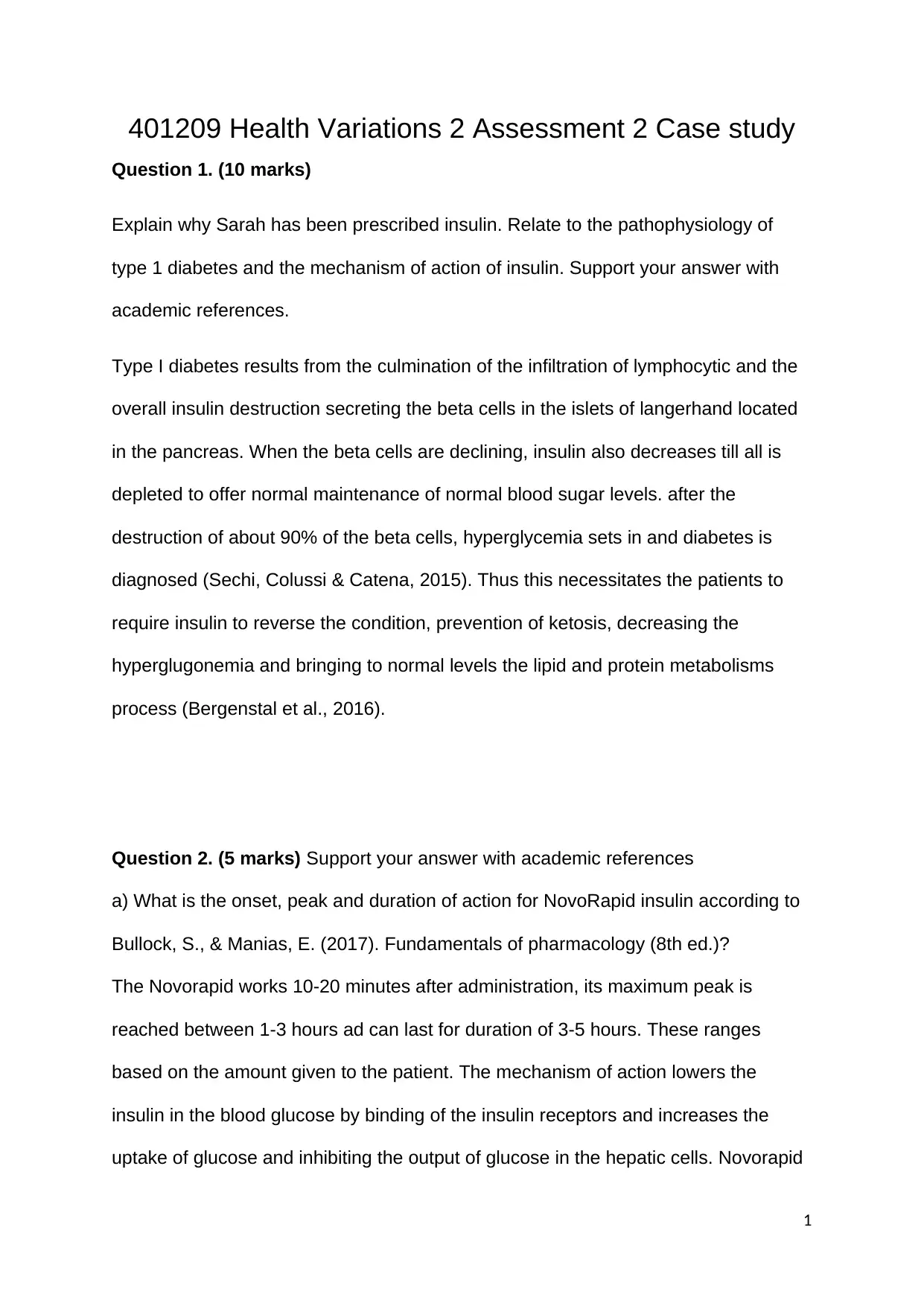
401209 Health Variations 2 Assessment 2 Case study
Question 1. (10 marks)
Explain why Sarah has been prescribed insulin. Relate to the pathophysiology of
type 1 diabetes and the mechanism of action of insulin. Support your answer with
academic references.
Type I diabetes results from the culmination of the infiltration of lymphocytic and the
overall insulin destruction secreting the beta cells in the islets of langerhand located
in the pancreas. When the beta cells are declining, insulin also decreases till all is
depleted to offer normal maintenance of normal blood sugar levels. after the
destruction of about 90% of the beta cells, hyperglycemia sets in and diabetes is
diagnosed (Sechi, Colussi & Catena, 2015). Thus this necessitates the patients to
require insulin to reverse the condition, prevention of ketosis, decreasing the
hyperglugonemia and bringing to normal levels the lipid and protein metabolisms
process (Bergenstal et al., 2016).
Question 2. (5 marks) Support your answer with academic references
a) What is the onset, peak and duration of action for NovoRapid insulin according to
Bullock, S., & Manias, E. (2017). Fundamentals of pharmacology (8th ed.)?
The Novorapid works 10-20 minutes after administration, its maximum peak is
reached between 1-3 hours ad can last for duration of 3-5 hours. These ranges
based on the amount given to the patient. The mechanism of action lowers the
insulin in the blood glucose by binding of the insulin receptors and increases the
uptake of glucose and inhibiting the output of glucose in the hepatic cells. Novorapid
1
Question 1. (10 marks)
Explain why Sarah has been prescribed insulin. Relate to the pathophysiology of
type 1 diabetes and the mechanism of action of insulin. Support your answer with
academic references.
Type I diabetes results from the culmination of the infiltration of lymphocytic and the
overall insulin destruction secreting the beta cells in the islets of langerhand located
in the pancreas. When the beta cells are declining, insulin also decreases till all is
depleted to offer normal maintenance of normal blood sugar levels. after the
destruction of about 90% of the beta cells, hyperglycemia sets in and diabetes is
diagnosed (Sechi, Colussi & Catena, 2015). Thus this necessitates the patients to
require insulin to reverse the condition, prevention of ketosis, decreasing the
hyperglugonemia and bringing to normal levels the lipid and protein metabolisms
process (Bergenstal et al., 2016).
Question 2. (5 marks) Support your answer with academic references
a) What is the onset, peak and duration of action for NovoRapid insulin according to
Bullock, S., & Manias, E. (2017). Fundamentals of pharmacology (8th ed.)?
The Novorapid works 10-20 minutes after administration, its maximum peak is
reached between 1-3 hours ad can last for duration of 3-5 hours. These ranges
based on the amount given to the patient. The mechanism of action lowers the
insulin in the blood glucose by binding of the insulin receptors and increases the
uptake of glucose and inhibiting the output of glucose in the hepatic cells. Novorapid
1
Secure Best Marks with AI Grader
Need help grading? Try our AI Grader for instant feedback on your assignments.
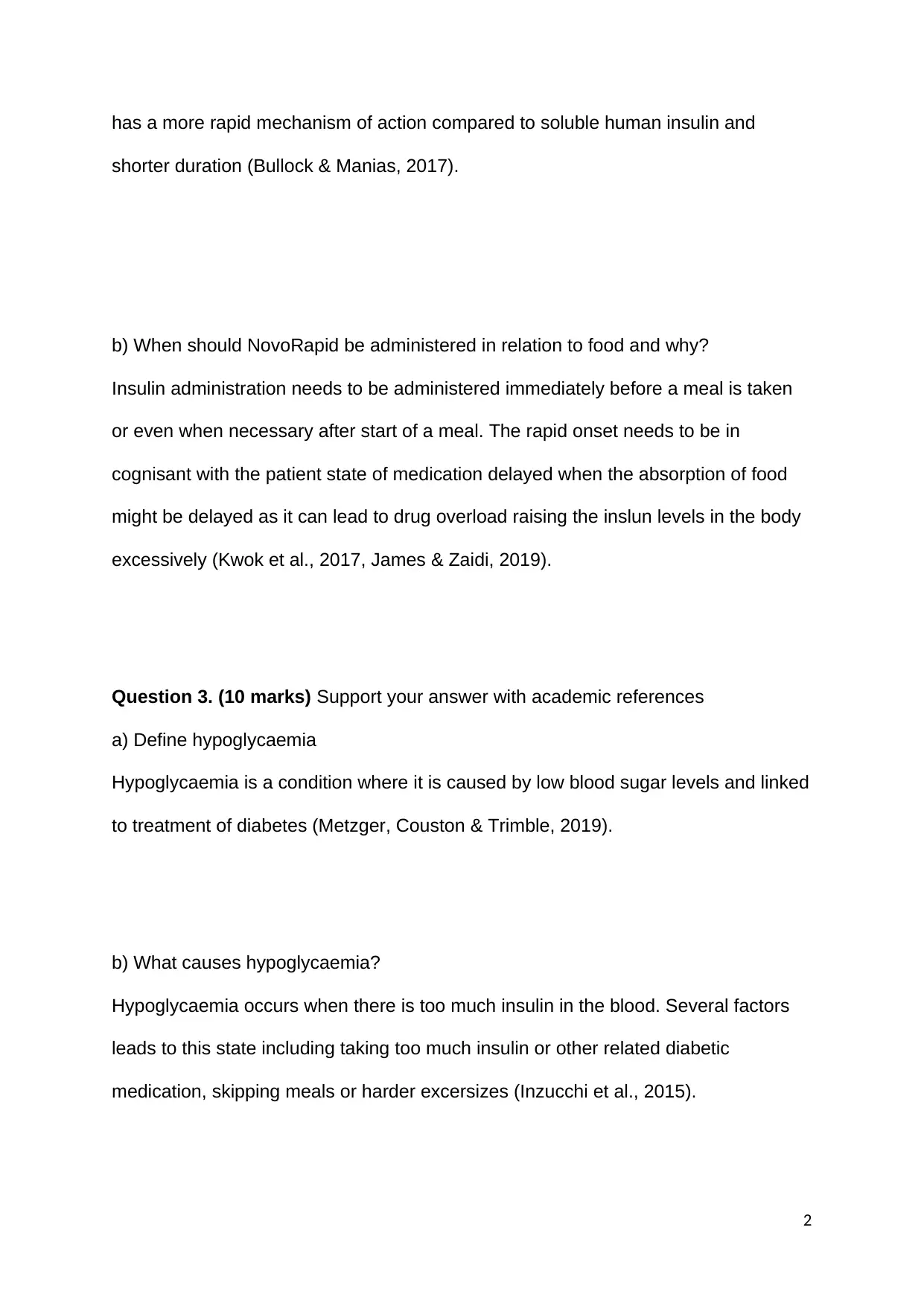
has a more rapid mechanism of action compared to soluble human insulin and
shorter duration (Bullock & Manias, 2017).
b) When should NovoRapid be administered in relation to food and why?
Insulin administration needs to be administered immediately before a meal is taken
or even when necessary after start of a meal. The rapid onset needs to be in
cognisant with the patient state of medication delayed when the absorption of food
might be delayed as it can lead to drug overload raising the inslun levels in the body
excessively (Kwok et al., 2017, James & Zaidi, 2019).
Question 3. (10 marks) Support your answer with academic references
a) Define hypoglycaemia
Hypoglycaemia is a condition where it is caused by low blood sugar levels and linked
to treatment of diabetes (Metzger, Couston & Trimble, 2019).
b) What causes hypoglycaemia?
Hypoglycaemia occurs when there is too much insulin in the blood. Several factors
leads to this state including taking too much insulin or other related diabetic
medication, skipping meals or harder excersizes (Inzucchi et al., 2015).
2
shorter duration (Bullock & Manias, 2017).
b) When should NovoRapid be administered in relation to food and why?
Insulin administration needs to be administered immediately before a meal is taken
or even when necessary after start of a meal. The rapid onset needs to be in
cognisant with the patient state of medication delayed when the absorption of food
might be delayed as it can lead to drug overload raising the inslun levels in the body
excessively (Kwok et al., 2017, James & Zaidi, 2019).
Question 3. (10 marks) Support your answer with academic references
a) Define hypoglycaemia
Hypoglycaemia is a condition where it is caused by low blood sugar levels and linked
to treatment of diabetes (Metzger, Couston & Trimble, 2019).
b) What causes hypoglycaemia?
Hypoglycaemia occurs when there is too much insulin in the blood. Several factors
leads to this state including taking too much insulin or other related diabetic
medication, skipping meals or harder excersizes (Inzucchi et al., 2015).
2
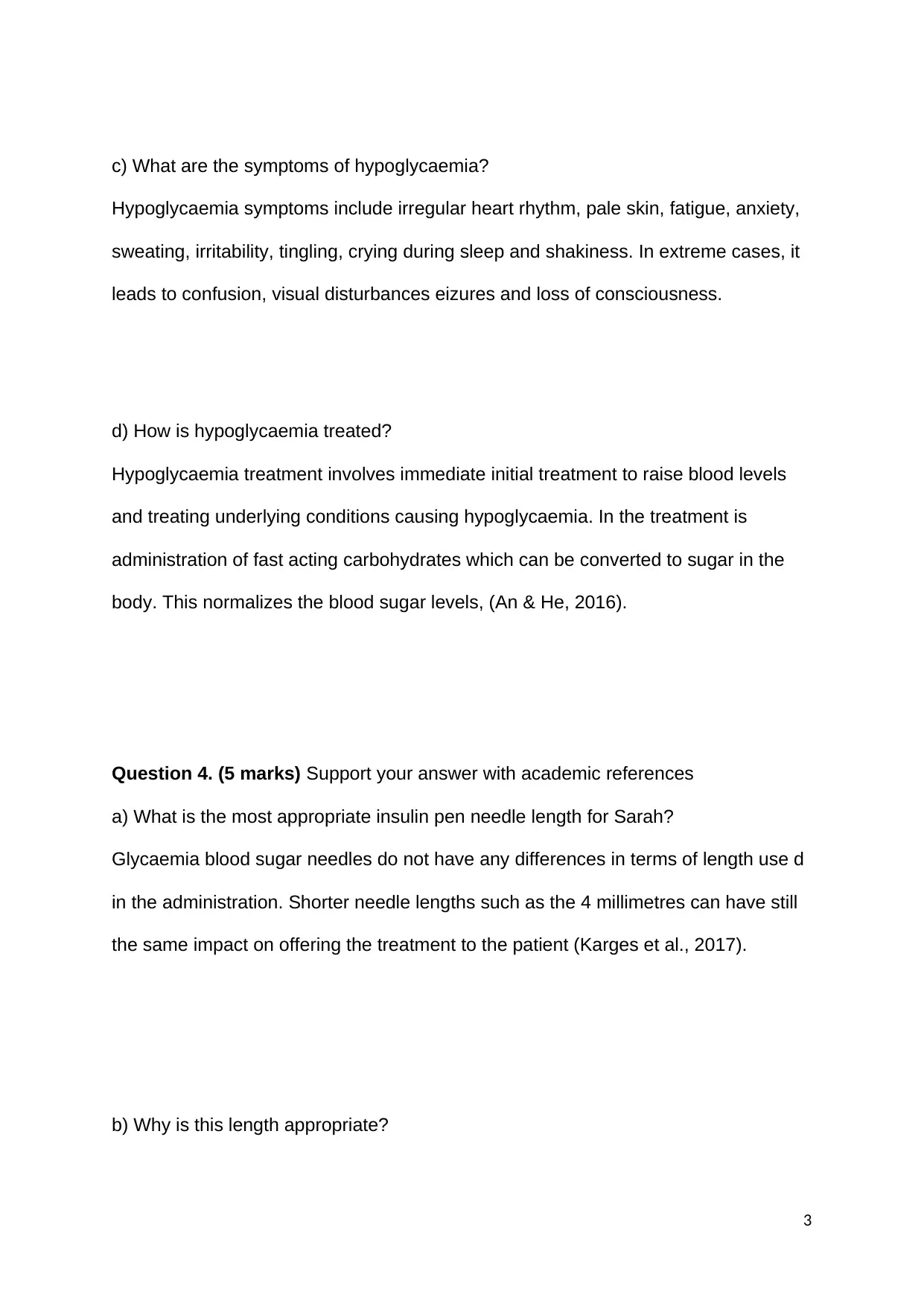
c) What are the symptoms of hypoglycaemia?
Hypoglycaemia symptoms include irregular heart rhythm, pale skin, fatigue, anxiety,
sweating, irritability, tingling, crying during sleep and shakiness. In extreme cases, it
leads to confusion, visual disturbances eizures and loss of consciousness.
d) How is hypoglycaemia treated?
Hypoglycaemia treatment involves immediate initial treatment to raise blood levels
and treating underlying conditions causing hypoglycaemia. In the treatment is
administration of fast acting carbohydrates which can be converted to sugar in the
body. This normalizes the blood sugar levels, (An & He, 2016).
Question 4. (5 marks) Support your answer with academic references
a) What is the most appropriate insulin pen needle length for Sarah?
Glycaemia blood sugar needles do not have any differences in terms of length use d
in the administration. Shorter needle lengths such as the 4 millimetres can have still
the same impact on offering the treatment to the patient (Karges et al., 2017).
b) Why is this length appropriate?
3
Hypoglycaemia symptoms include irregular heart rhythm, pale skin, fatigue, anxiety,
sweating, irritability, tingling, crying during sleep and shakiness. In extreme cases, it
leads to confusion, visual disturbances eizures and loss of consciousness.
d) How is hypoglycaemia treated?
Hypoglycaemia treatment involves immediate initial treatment to raise blood levels
and treating underlying conditions causing hypoglycaemia. In the treatment is
administration of fast acting carbohydrates which can be converted to sugar in the
body. This normalizes the blood sugar levels, (An & He, 2016).
Question 4. (5 marks) Support your answer with academic references
a) What is the most appropriate insulin pen needle length for Sarah?
Glycaemia blood sugar needles do not have any differences in terms of length use d
in the administration. Shorter needle lengths such as the 4 millimetres can have still
the same impact on offering the treatment to the patient (Karges et al., 2017).
b) Why is this length appropriate?
3
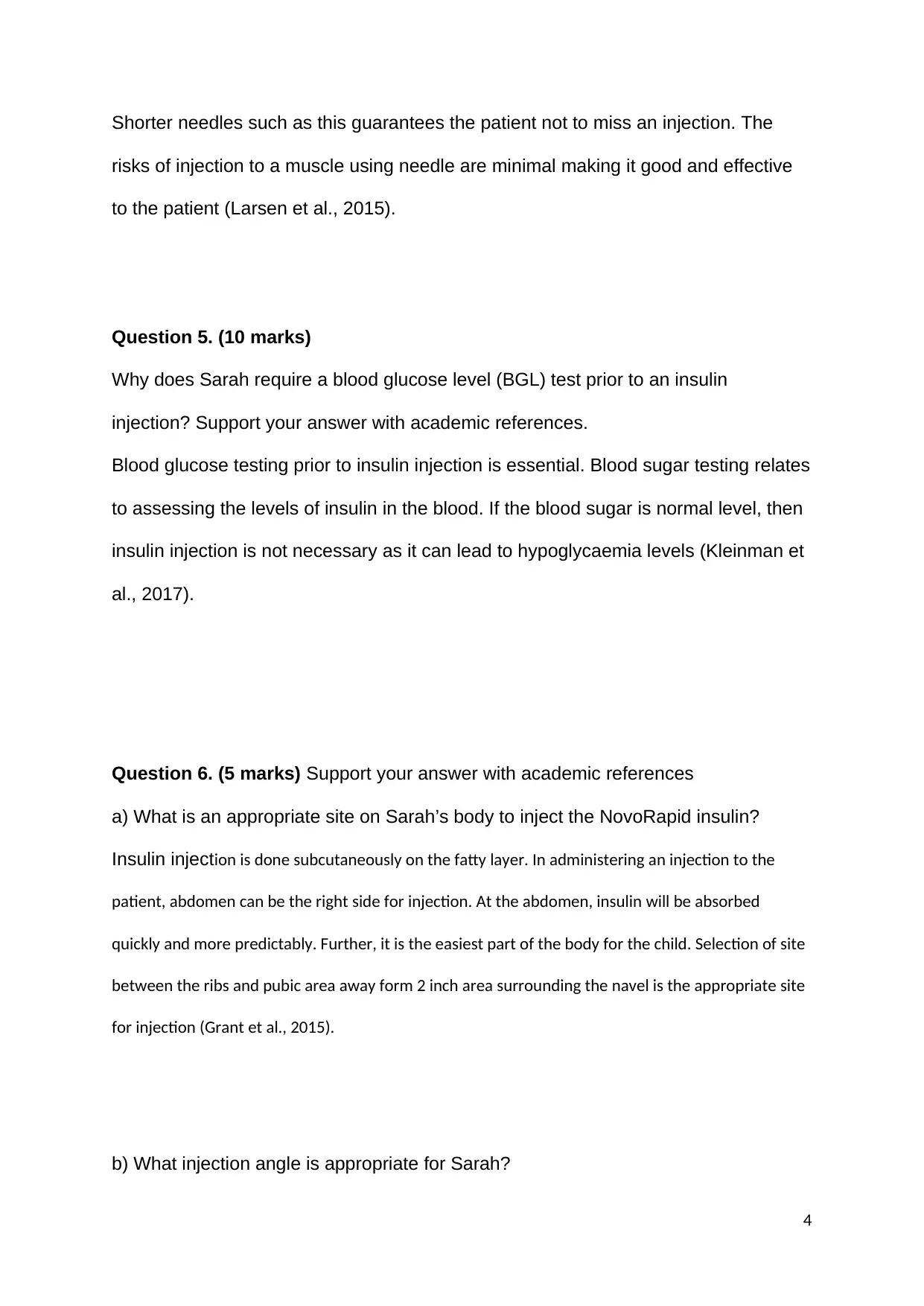
Shorter needles such as this guarantees the patient not to miss an injection. The
risks of injection to a muscle using needle are minimal making it good and effective
to the patient (Larsen et al., 2015).
Question 5. (10 marks)
Why does Sarah require a blood glucose level (BGL) test prior to an insulin
injection? Support your answer with academic references.
Blood glucose testing prior to insulin injection is essential. Blood sugar testing relates
to assessing the levels of insulin in the blood. If the blood sugar is normal level, then
insulin injection is not necessary as it can lead to hypoglycaemia levels (Kleinman et
al., 2017).
Question 6. (5 marks) Support your answer with academic references
a) What is an appropriate site on Sarah’s body to inject the NovoRapid insulin?
Insulin injection is done subcutaneously on the fatty layer. In administering an injection to the
patient, abdomen can be the right side for injection. At the abdomen, insulin will be absorbed
quickly and more predictably. Further, it is the easiest part of the body for the child. Selection of site
between the ribs and pubic area away form 2 inch area surrounding the navel is the appropriate site
for injection (Grant et al., 2015).
b) What injection angle is appropriate for Sarah?
4
risks of injection to a muscle using needle are minimal making it good and effective
to the patient (Larsen et al., 2015).
Question 5. (10 marks)
Why does Sarah require a blood glucose level (BGL) test prior to an insulin
injection? Support your answer with academic references.
Blood glucose testing prior to insulin injection is essential. Blood sugar testing relates
to assessing the levels of insulin in the blood. If the blood sugar is normal level, then
insulin injection is not necessary as it can lead to hypoglycaemia levels (Kleinman et
al., 2017).
Question 6. (5 marks) Support your answer with academic references
a) What is an appropriate site on Sarah’s body to inject the NovoRapid insulin?
Insulin injection is done subcutaneously on the fatty layer. In administering an injection to the
patient, abdomen can be the right side for injection. At the abdomen, insulin will be absorbed
quickly and more predictably. Further, it is the easiest part of the body for the child. Selection of site
between the ribs and pubic area away form 2 inch area surrounding the navel is the appropriate site
for injection (Grant et al., 2015).
b) What injection angle is appropriate for Sarah?
4
Secure Best Marks with AI Grader
Need help grading? Try our AI Grader for instant feedback on your assignments.
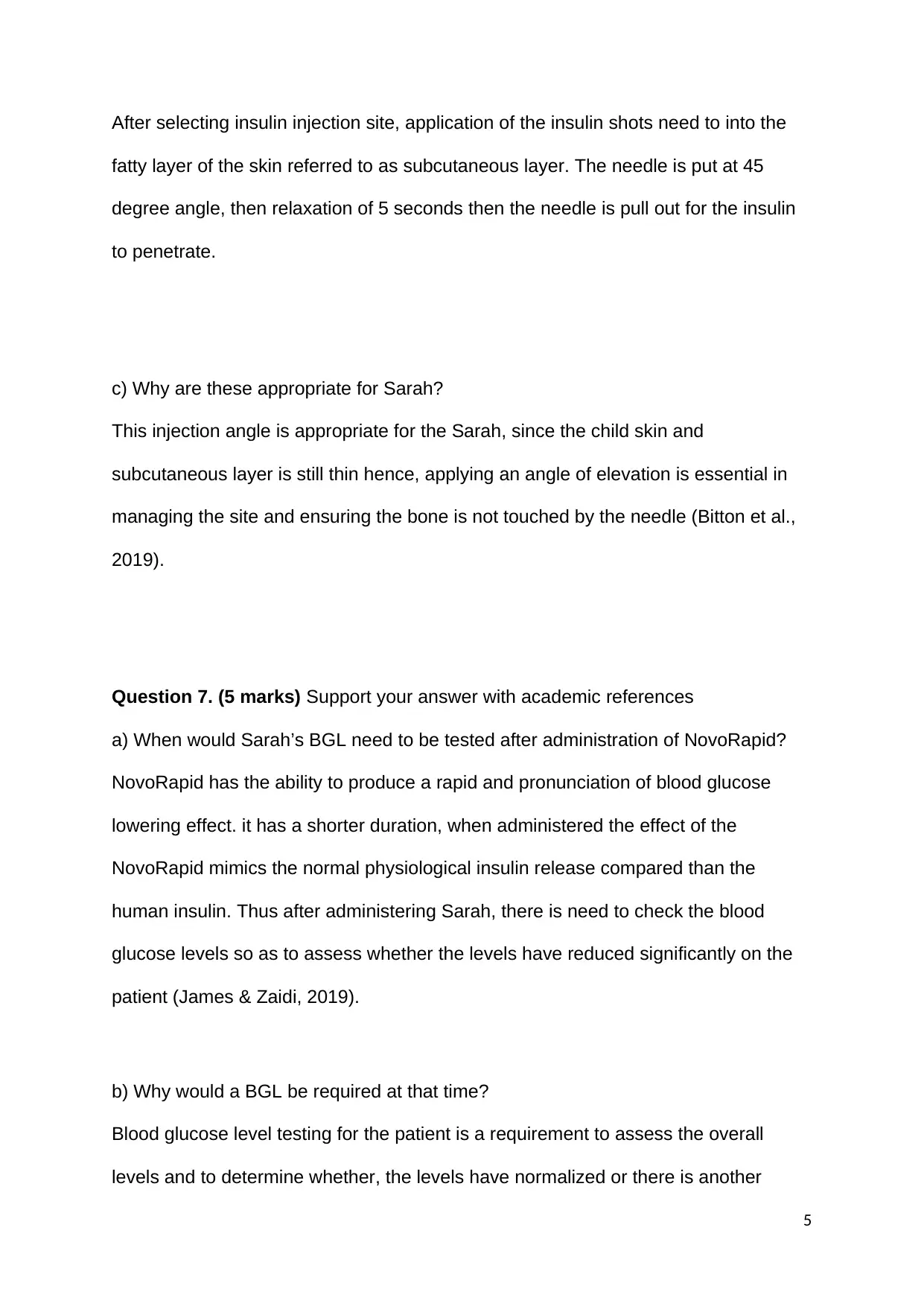
After selecting insulin injection site, application of the insulin shots need to into the
fatty layer of the skin referred to as subcutaneous layer. The needle is put at 45
degree angle, then relaxation of 5 seconds then the needle is pull out for the insulin
to penetrate.
c) Why are these appropriate for Sarah?
This injection angle is appropriate for the Sarah, since the child skin and
subcutaneous layer is still thin hence, applying an angle of elevation is essential in
managing the site and ensuring the bone is not touched by the needle (Bitton et al.,
2019).
Question 7. (5 marks) Support your answer with academic references
a) When would Sarah’s BGL need to be tested after administration of NovoRapid?
NovoRapid has the ability to produce a rapid and pronunciation of blood glucose
lowering effect. it has a shorter duration, when administered the effect of the
NovoRapid mimics the normal physiological insulin release compared than the
human insulin. Thus after administering Sarah, there is need to check the blood
glucose levels so as to assess whether the levels have reduced significantly on the
patient (James & Zaidi, 2019).
b) Why would a BGL be required at that time?
Blood glucose level testing for the patient is a requirement to assess the overall
levels and to determine whether, the levels have normalized or there is another
5
fatty layer of the skin referred to as subcutaneous layer. The needle is put at 45
degree angle, then relaxation of 5 seconds then the needle is pull out for the insulin
to penetrate.
c) Why are these appropriate for Sarah?
This injection angle is appropriate for the Sarah, since the child skin and
subcutaneous layer is still thin hence, applying an angle of elevation is essential in
managing the site and ensuring the bone is not touched by the needle (Bitton et al.,
2019).
Question 7. (5 marks) Support your answer with academic references
a) When would Sarah’s BGL need to be tested after administration of NovoRapid?
NovoRapid has the ability to produce a rapid and pronunciation of blood glucose
lowering effect. it has a shorter duration, when administered the effect of the
NovoRapid mimics the normal physiological insulin release compared than the
human insulin. Thus after administering Sarah, there is need to check the blood
glucose levels so as to assess whether the levels have reduced significantly on the
patient (James & Zaidi, 2019).
b) Why would a BGL be required at that time?
Blood glucose level testing for the patient is a requirement to assess the overall
levels and to determine whether, the levels have normalized or there is another
5
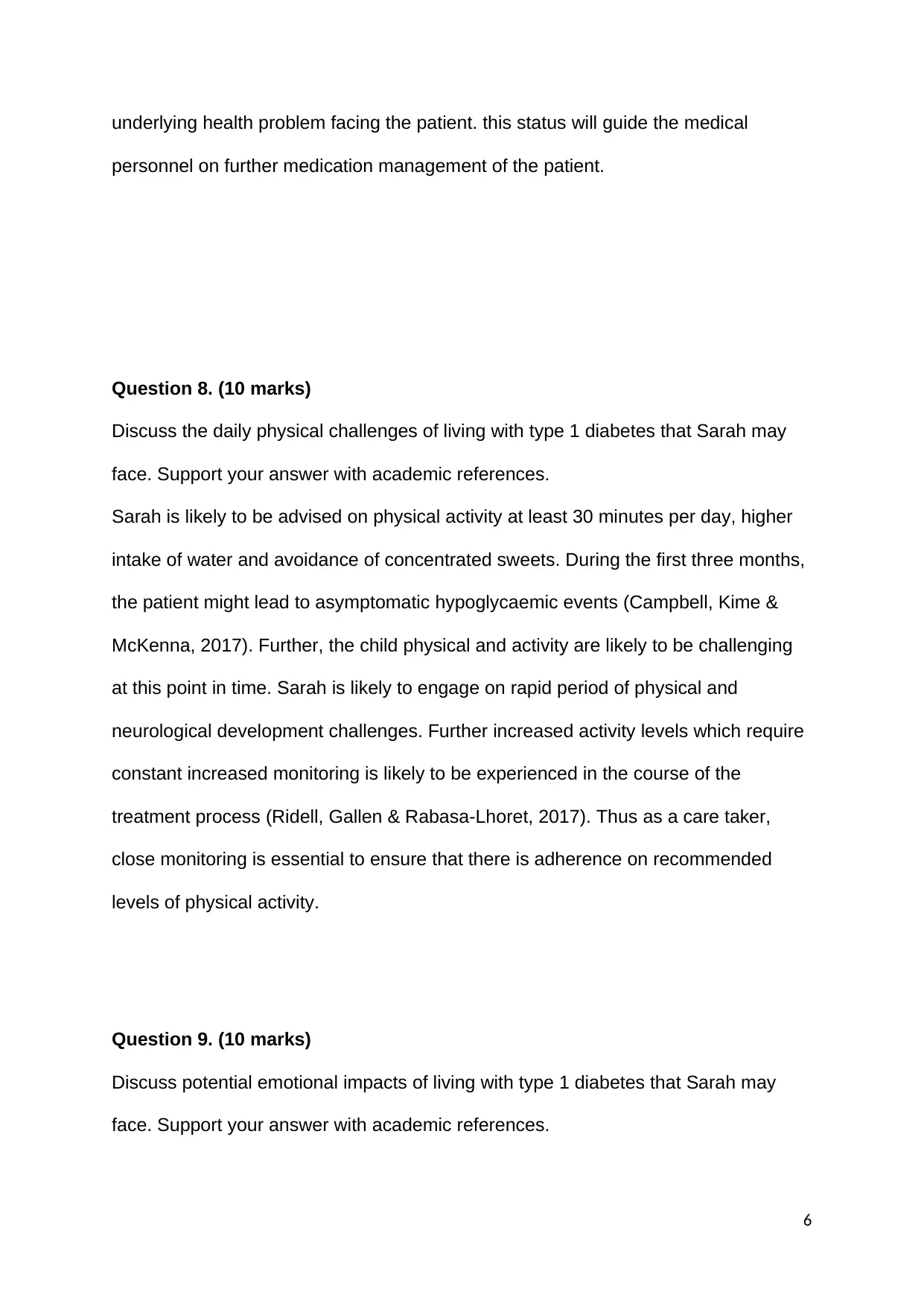
underlying health problem facing the patient. this status will guide the medical
personnel on further medication management of the patient.
Question 8. (10 marks)
Discuss the daily physical challenges of living with type 1 diabetes that Sarah may
face. Support your answer with academic references.
Sarah is likely to be advised on physical activity at least 30 minutes per day, higher
intake of water and avoidance of concentrated sweets. During the first three months,
the patient might lead to asymptomatic hypoglycaemic events (Campbell, Kime &
McKenna, 2017). Further, the child physical and activity are likely to be challenging
at this point in time. Sarah is likely to engage on rapid period of physical and
neurological development challenges. Further increased activity levels which require
constant increased monitoring is likely to be experienced in the course of the
treatment process (Ridell, Gallen & Rabasa-Lhoret, 2017). Thus as a care taker,
close monitoring is essential to ensure that there is adherence on recommended
levels of physical activity.
Question 9. (10 marks)
Discuss potential emotional impacts of living with type 1 diabetes that Sarah may
face. Support your answer with academic references.
6
personnel on further medication management of the patient.
Question 8. (10 marks)
Discuss the daily physical challenges of living with type 1 diabetes that Sarah may
face. Support your answer with academic references.
Sarah is likely to be advised on physical activity at least 30 minutes per day, higher
intake of water and avoidance of concentrated sweets. During the first three months,
the patient might lead to asymptomatic hypoglycaemic events (Campbell, Kime &
McKenna, 2017). Further, the child physical and activity are likely to be challenging
at this point in time. Sarah is likely to engage on rapid period of physical and
neurological development challenges. Further increased activity levels which require
constant increased monitoring is likely to be experienced in the course of the
treatment process (Ridell, Gallen & Rabasa-Lhoret, 2017). Thus as a care taker,
close monitoring is essential to ensure that there is adherence on recommended
levels of physical activity.
Question 9. (10 marks)
Discuss potential emotional impacts of living with type 1 diabetes that Sarah may
face. Support your answer with academic references.
6
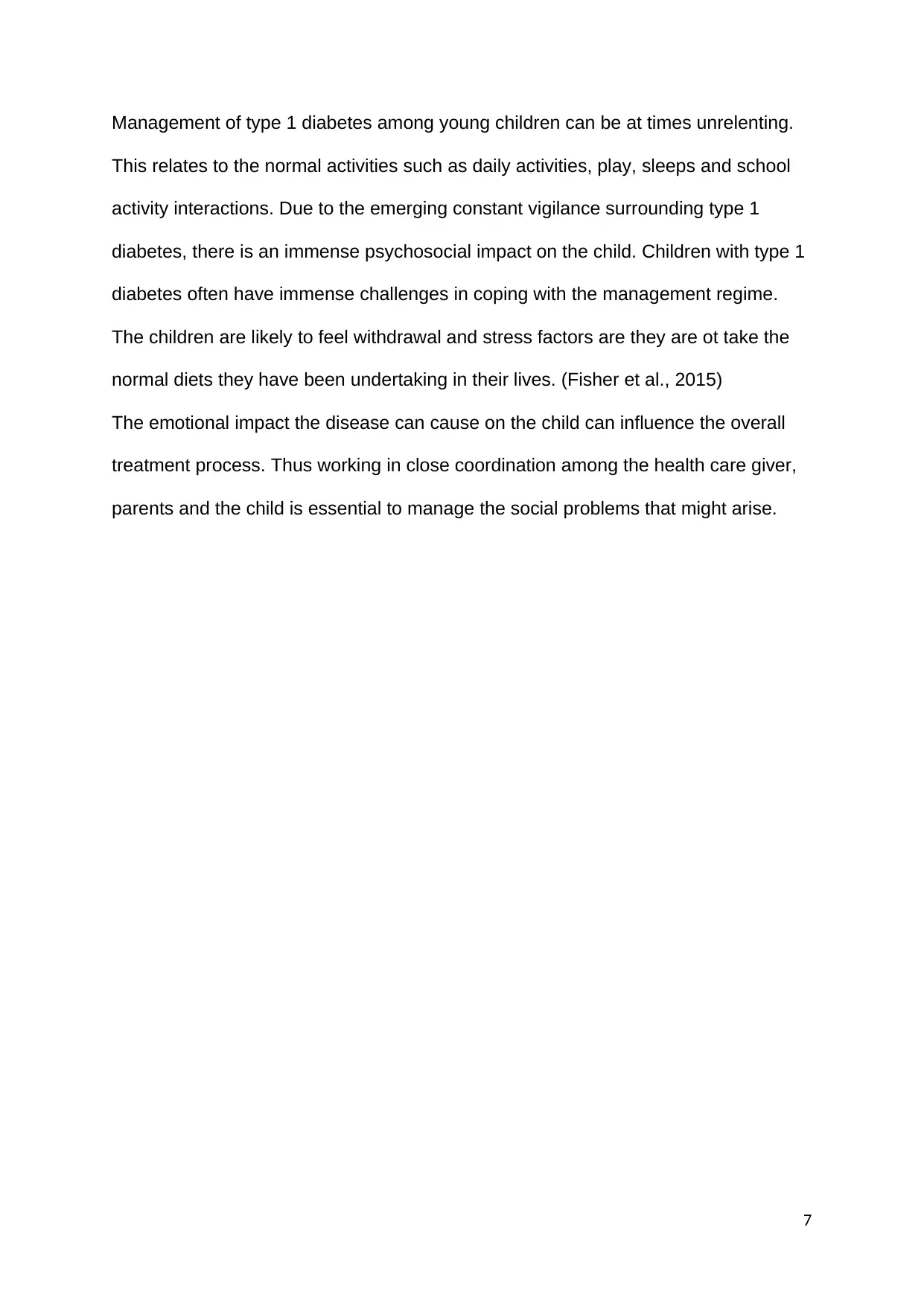
Management of type 1 diabetes among young children can be at times unrelenting.
This relates to the normal activities such as daily activities, play, sleeps and school
activity interactions. Due to the emerging constant vigilance surrounding type 1
diabetes, there is an immense psychosocial impact on the child. Children with type 1
diabetes often have immense challenges in coping with the management regime.
The children are likely to feel withdrawal and stress factors are they are ot take the
normal diets they have been undertaking in their lives. (Fisher et al., 2015)
The emotional impact the disease can cause on the child can influence the overall
treatment process. Thus working in close coordination among the health care giver,
parents and the child is essential to manage the social problems that might arise.
7
This relates to the normal activities such as daily activities, play, sleeps and school
activity interactions. Due to the emerging constant vigilance surrounding type 1
diabetes, there is an immense psychosocial impact on the child. Children with type 1
diabetes often have immense challenges in coping with the management regime.
The children are likely to feel withdrawal and stress factors are they are ot take the
normal diets they have been undertaking in their lives. (Fisher et al., 2015)
The emotional impact the disease can cause on the child can influence the overall
treatment process. Thus working in close coordination among the health care giver,
parents and the child is essential to manage the social problems that might arise.
7
Paraphrase This Document
Need a fresh take? Get an instant paraphrase of this document with our AI Paraphraser
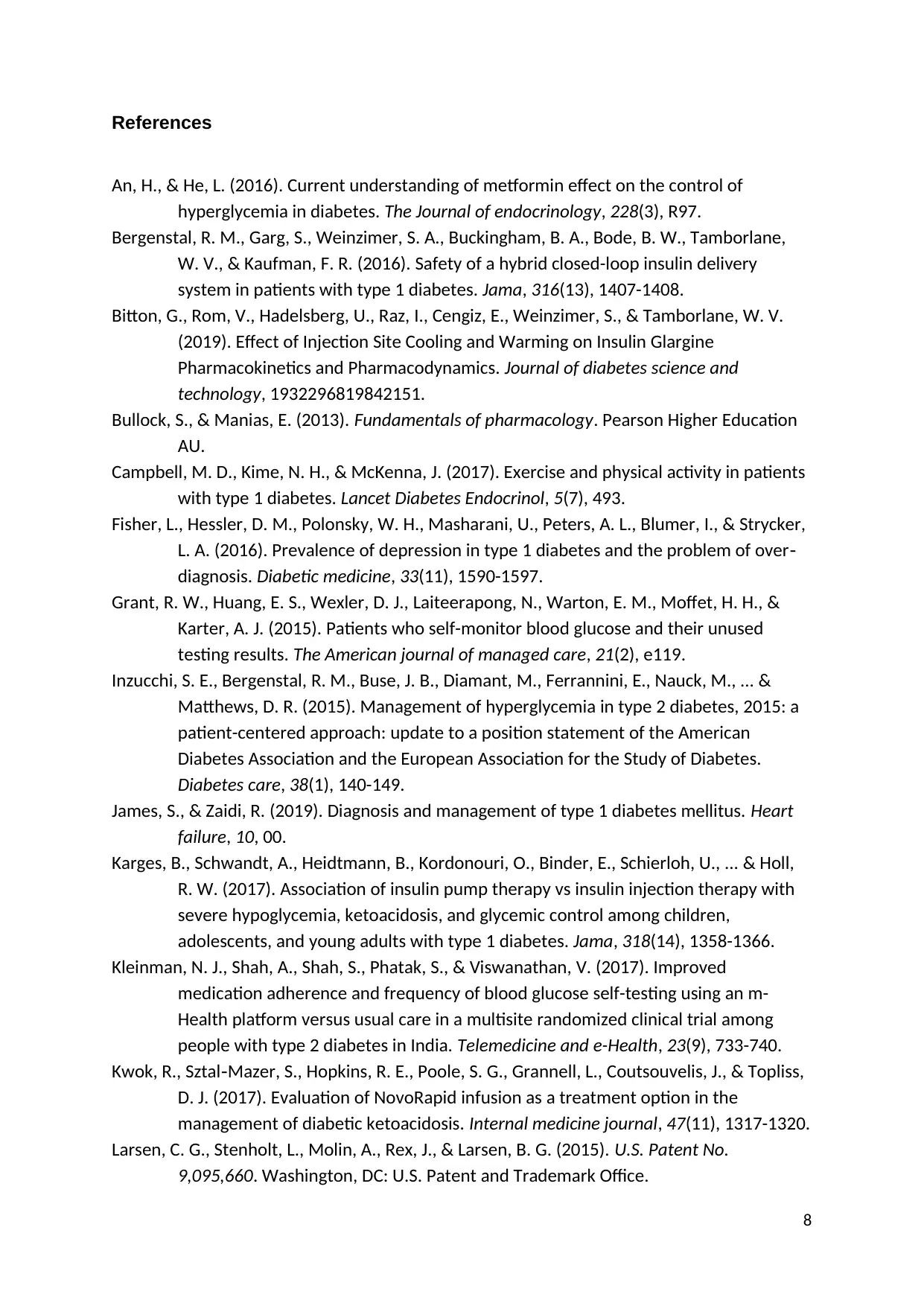
References
An, H., & He, L. (2016). Current understanding of metformin effect on the control of
hyperglycemia in diabetes. The Journal of endocrinology, 228(3), R97.
Bergenstal, R. M., Garg, S., Weinzimer, S. A., Buckingham, B. A., Bode, B. W., Tamborlane,
W. V., & Kaufman, F. R. (2016). Safety of a hybrid closed-loop insulin delivery
system in patients with type 1 diabetes. Jama, 316(13), 1407-1408.
Bitton, G., Rom, V., Hadelsberg, U., Raz, I., Cengiz, E., Weinzimer, S., & Tamborlane, W. V.
(2019). Effect of Injection Site Cooling and Warming on Insulin Glargine
Pharmacokinetics and Pharmacodynamics. Journal of diabetes science and
technology, 1932296819842151.
Bullock, S., & Manias, E. (2013). Fundamentals of pharmacology. Pearson Higher Education
AU.
Campbell, M. D., Kime, N. H., & McKenna, J. (2017). Exercise and physical activity in patients
with type 1 diabetes. Lancet Diabetes Endocrinol, 5(7), 493.
Fisher, L., Hessler, D. M., Polonsky, W. H., Masharani, U., Peters, A. L., Blumer, I., & Strycker,
L. A. (2016). Prevalence of depression in type 1 diabetes and the problem of over‐
diagnosis. Diabetic medicine, 33(11), 1590-1597.
Grant, R. W., Huang, E. S., Wexler, D. J., Laiteerapong, N., Warton, E. M., Moffet, H. H., &
Karter, A. J. (2015). Patients who self-monitor blood glucose and their unused
testing results. The American journal of managed care, 21(2), e119.
Inzucchi, S. E., Bergenstal, R. M., Buse, J. B., Diamant, M., Ferrannini, E., Nauck, M., ... &
Matthews, D. R. (2015). Management of hyperglycemia in type 2 diabetes, 2015: a
patient-centered approach: update to a position statement of the American
Diabetes Association and the European Association for the Study of Diabetes.
Diabetes care, 38(1), 140-149.
James, S., & Zaidi, R. (2019). Diagnosis and management of type 1 diabetes mellitus. Heart
failure, 10, 00.
Karges, B., Schwandt, A., Heidtmann, B., Kordonouri, O., Binder, E., Schierloh, U., ... & Holl,
R. W. (2017). Association of insulin pump therapy vs insulin injection therapy with
severe hypoglycemia, ketoacidosis, and glycemic control among children,
adolescents, and young adults with type 1 diabetes. Jama, 318(14), 1358-1366.
Kleinman, N. J., Shah, A., Shah, S., Phatak, S., & Viswanathan, V. (2017). Improved
medication adherence and frequency of blood glucose self-testing using an m-
Health platform versus usual care in a multisite randomized clinical trial among
people with type 2 diabetes in India. Telemedicine and e-Health, 23(9), 733-740.
Kwok, R., Sztal‐Mazer, S., Hopkins, R. E., Poole, S. G., Grannell, L., Coutsouvelis, J., & Topliss,
D. J. (2017). Evaluation of NovoRapid infusion as a treatment option in the
management of diabetic ketoacidosis. Internal medicine journal, 47(11), 1317-1320.
Larsen, C. G., Stenholt, L., Molin, A., Rex, J., & Larsen, B. G. (2015). U.S. Patent No.
9,095,660. Washington, DC: U.S. Patent and Trademark Office.
8
An, H., & He, L. (2016). Current understanding of metformin effect on the control of
hyperglycemia in diabetes. The Journal of endocrinology, 228(3), R97.
Bergenstal, R. M., Garg, S., Weinzimer, S. A., Buckingham, B. A., Bode, B. W., Tamborlane,
W. V., & Kaufman, F. R. (2016). Safety of a hybrid closed-loop insulin delivery
system in patients with type 1 diabetes. Jama, 316(13), 1407-1408.
Bitton, G., Rom, V., Hadelsberg, U., Raz, I., Cengiz, E., Weinzimer, S., & Tamborlane, W. V.
(2019). Effect of Injection Site Cooling and Warming on Insulin Glargine
Pharmacokinetics and Pharmacodynamics. Journal of diabetes science and
technology, 1932296819842151.
Bullock, S., & Manias, E. (2013). Fundamentals of pharmacology. Pearson Higher Education
AU.
Campbell, M. D., Kime, N. H., & McKenna, J. (2017). Exercise and physical activity in patients
with type 1 diabetes. Lancet Diabetes Endocrinol, 5(7), 493.
Fisher, L., Hessler, D. M., Polonsky, W. H., Masharani, U., Peters, A. L., Blumer, I., & Strycker,
L. A. (2016). Prevalence of depression in type 1 diabetes and the problem of over‐
diagnosis. Diabetic medicine, 33(11), 1590-1597.
Grant, R. W., Huang, E. S., Wexler, D. J., Laiteerapong, N., Warton, E. M., Moffet, H. H., &
Karter, A. J. (2015). Patients who self-monitor blood glucose and their unused
testing results. The American journal of managed care, 21(2), e119.
Inzucchi, S. E., Bergenstal, R. M., Buse, J. B., Diamant, M., Ferrannini, E., Nauck, M., ... &
Matthews, D. R. (2015). Management of hyperglycemia in type 2 diabetes, 2015: a
patient-centered approach: update to a position statement of the American
Diabetes Association and the European Association for the Study of Diabetes.
Diabetes care, 38(1), 140-149.
James, S., & Zaidi, R. (2019). Diagnosis and management of type 1 diabetes mellitus. Heart
failure, 10, 00.
Karges, B., Schwandt, A., Heidtmann, B., Kordonouri, O., Binder, E., Schierloh, U., ... & Holl,
R. W. (2017). Association of insulin pump therapy vs insulin injection therapy with
severe hypoglycemia, ketoacidosis, and glycemic control among children,
adolescents, and young adults with type 1 diabetes. Jama, 318(14), 1358-1366.
Kleinman, N. J., Shah, A., Shah, S., Phatak, S., & Viswanathan, V. (2017). Improved
medication adherence and frequency of blood glucose self-testing using an m-
Health platform versus usual care in a multisite randomized clinical trial among
people with type 2 diabetes in India. Telemedicine and e-Health, 23(9), 733-740.
Kwok, R., Sztal‐Mazer, S., Hopkins, R. E., Poole, S. G., Grannell, L., Coutsouvelis, J., & Topliss,
D. J. (2017). Evaluation of NovoRapid infusion as a treatment option in the
management of diabetic ketoacidosis. Internal medicine journal, 47(11), 1317-1320.
Larsen, C. G., Stenholt, L., Molin, A., Rex, J., & Larsen, B. G. (2015). U.S. Patent No.
9,095,660. Washington, DC: U.S. Patent and Trademark Office.
8
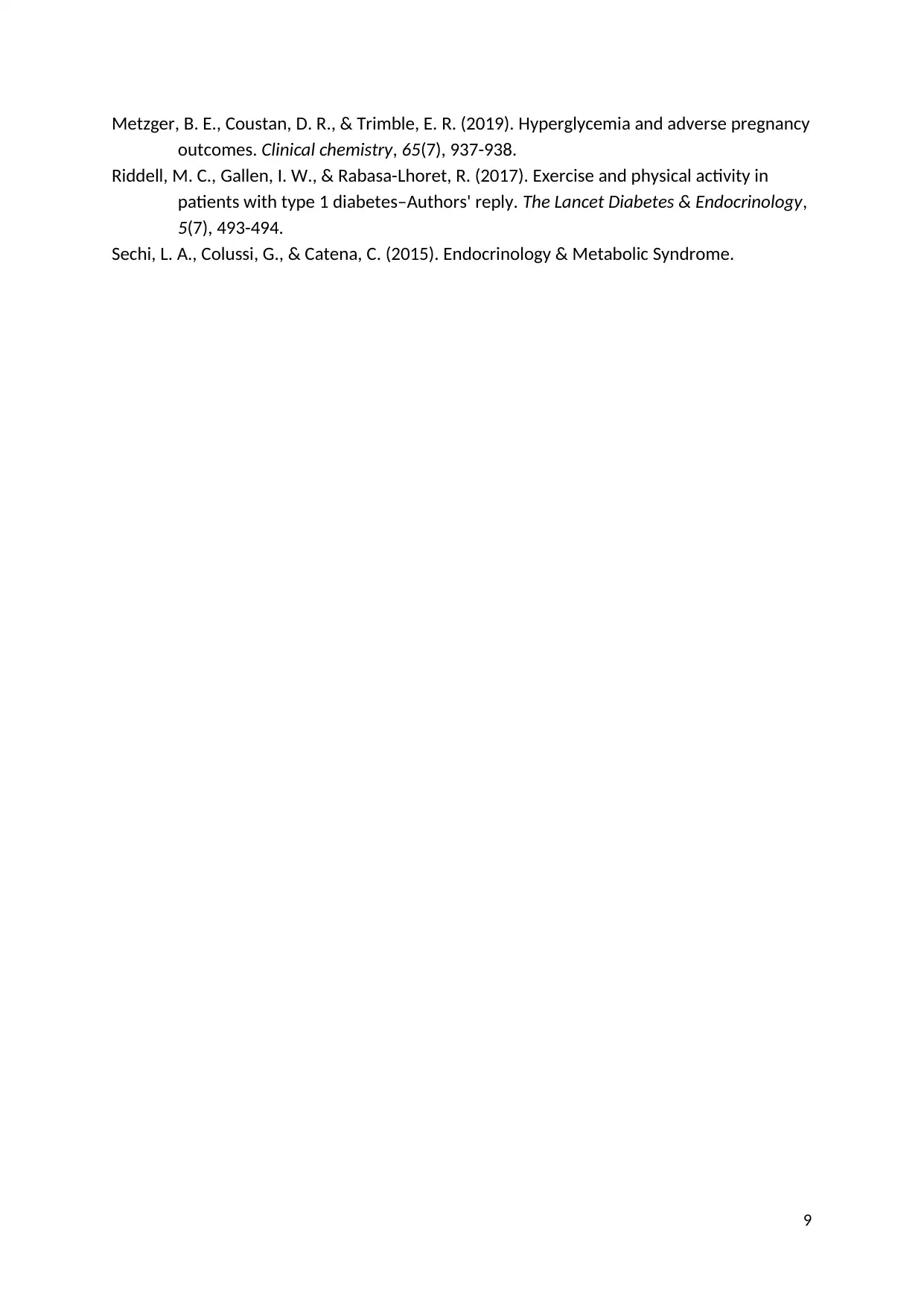
Metzger, B. E., Coustan, D. R., & Trimble, E. R. (2019). Hyperglycemia and adverse pregnancy
outcomes. Clinical chemistry, 65(7), 937-938.
Riddell, M. C., Gallen, I. W., & Rabasa-Lhoret, R. (2017). Exercise and physical activity in
patients with type 1 diabetes–Authors' reply. The Lancet Diabetes & Endocrinology,
5(7), 493-494.
Sechi, L. A., Colussi, G., & Catena, C. (2015). Endocrinology & Metabolic Syndrome.
9
outcomes. Clinical chemistry, 65(7), 937-938.
Riddell, M. C., Gallen, I. W., & Rabasa-Lhoret, R. (2017). Exercise and physical activity in
patients with type 1 diabetes–Authors' reply. The Lancet Diabetes & Endocrinology,
5(7), 493-494.
Sechi, L. A., Colussi, G., & Catena, C. (2015). Endocrinology & Metabolic Syndrome.
9
1 out of 9
Related Documents
Your All-in-One AI-Powered Toolkit for Academic Success.
+13062052269
info@desklib.com
Available 24*7 on WhatsApp / Email
![[object Object]](/_next/static/media/star-bottom.7253800d.svg)
Unlock your academic potential
© 2024 | Zucol Services PVT LTD | All rights reserved.




